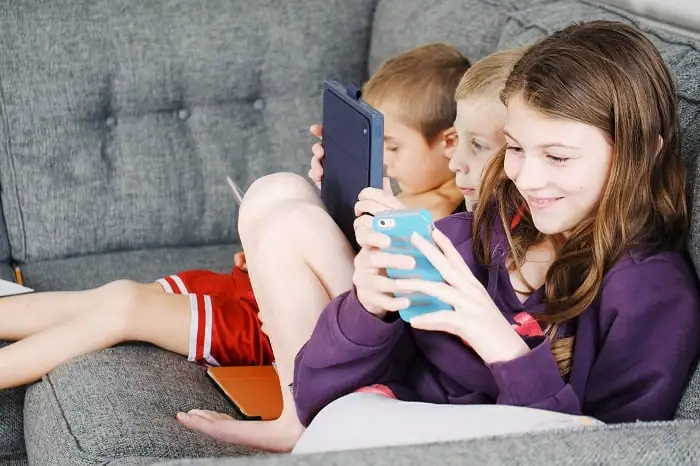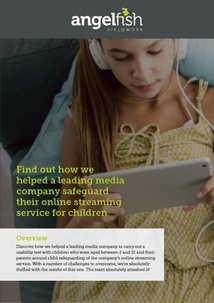
Nine top tips for usability testing with children & young people
As user experience continues to become a key brand differentiator, usability testing is growing in popularity. In a nutshell, usability testing essentially involves getting real users to interact with your website, app, or product by completing a selection of tasks and observing them as they do it. By tracking how easy your product is to use, you can identify any areas that need improving and make any necessary changes so that you can deliver an efficient and effective user experience. So, it’s pretty easy to see why usability testing is such an important part of the modern day researcher’s toolkit. But what about usability testing with children and young people?
Usability testing with young people
Market research with children and young people is essential for forward-thinking brands. For starters, children tend to be more open and honest than adults, which means more insightful results, and they also have their own unique and important perspectives on products and websites. What’s more, kids today are the influencers of tomorrow - and their spending power is growing by the day. So if you want to future-proof your brand, it’s essential that you know how to reach out to and engage with young people.
However, children and young people can be a tricky target audience to work with - and as such, usability testing with young people isn’t without its challenges. They can be unreliable, they are sometimes difficult to engage with, and they have a shorter attention span than older generations. As a result, you’ll need to adapt your methodology, recruitment methods, timeframes and even the language you use accordingly. Lucky, then, that we’re on hand to share our top usability testing tips...
1. Be sensitive to maturity levels
When it comes to usability testing with children and young people, it’s really important to be mindful of age ranges. Five year olds will have very different abilities to 10 year olds, for example, so you will need to bear the age range of your audience in mind when designing your usability test. Even when it comes to teenagers, it makes sense to specify certain age levels or year groups to make sure your test is suitable for the children’s ability and levels of maturity.
2. Make sure they understand what’s being asked of them
In order to get the most out of your usability test, your participants need to have an accurate understanding of the scenario being presented to them and be clear on what they need to do and why - and this is even more important with children. One good way to do this is by asking them to rephrase scenarios/goals in their own words so you can be certain that they understand what is expected of them.
3. Speak to them in their own language
This leads us on to our next point: young people today communicate differently. From emojis to abbreviations, if you want children to engage with your research, you need to speak to them in a language they understand. Make sure you use age-appropriate language; that doesn’t mean you have to dumb it down, but try and simplify things as much as possible, especially if your usability test spans different age groups.
4. Make sure they are comfortable
When it comes to usability testing with children, it’s really important that they feel relaxed and at ease. First of all, choose a safe and appropriate location; testing in a familiar environment or even at home can really help things to run smoothly. You could also consider allowing some time at the beginning of the session for the moderator to meet the child - either virtually or face to face! - and if your test is in-person rather than online, it’s worth giving younger children the option to have their parents stay in the room with them, too.

5. Consider logistics
Another way to ensure your usability test runs smoothly is by carefully considering all the logistics. When will the session take place? After school children will have homework to complete and will probably be tired, which could have an impact on the quality of the results. How long will the session last? Remember that children have much shorter attention spans than adults and will lose interest much more quickly, so you should limit your sessions to one hour or less and take breaks if they become tired or distracted.
6. Make things as easy as possible
Life can be stressful enough with kids, so it’s important to make things as easy as possible for stressed-out parents. Let them know clear directions, what is expected of them upon arrival, whether or not the children will be recorded, what the recordings will be used for; the more info parents have to hand, the more smoothly things will run on the day! You should also be prepared for siblings to come and consider having activities for younger kids at hand to make things as stress-free as possible.
7. Keep it interesting
In all market research projects it’s a good idea to offer a variety of tasks and activities to keep your participants engaged and interested - and this is even more important when conducting research with children and young people. Kids today are more tech-savvy than ever before. As digital natives, they’ve never known a life without the internet, and as such, they expect access to information instantly. Be sure to bear this in mind when designing your test: keep it as short and sweet as possible, and try and make things fun and age-appropriate too. For example, when possible, visual scales such as smiley faces or emojis can work really well.
8. Offer an age appropriate incentive
It’s pretty common to offer an incentive to thank your participants for taking part in your market research - and it shouldn’t be any different with children! Just make sure your incentive is safe and suitable for their age: gift cards for an age-appropriate shop are always a good bet, as are iTunes vouchers. For more incentive ideas for children, check out this blog.
9. Always over-recruit
Finally, if you want to ensure your usability testing runs smoothly, you should always, always over-recruit. If, on the day of your testing sessions you find that your participants aren’t suitable for some reason - for example, perhaps some of the children are too shy - or if they have failed to show up on time, having to scramble and re-recruit will be expensive and time-consuming. What’s more, you might have to settle for poorly suited participants, which will depreciate the value of your testing. An over-recruit is the best way to avoid these worst-case scenarios, especially when it comes to research with children!
How Angelfish can help
As a user recruitment agency for the modern-day researcher, at Angelfish,there’s nothing we don’t know about recruiting for usability testing. In fact, we pride ourselves on helping our clients to find the very best people for their UX research. However specific your criteria, you can count on our team to recruit the perfect participants for your usability test so that you can get to grips with what your customers are really thinking and make informed, customer-centric decisions.
You see, we’ll really get to know the objectives of your study, what you are trying to achieve and why, before carrying out completely bespoke and targeted recruitment campaigns designed to source the best possible participants. From our diverse panel of over 26,000 opt-in respondents, combined with cleverly targeted social media adverts and refer a friend campaigns, we will leave no stone unturned in our search for the perfect participants, so you can be confident you are speaking to a true representation of your customers.
Our success
Want to find out more about the Angelfish approach? Check out our latest case study to find out how we helped a leading media company to carry out a usability test with parents and children aged two to 12 around child safeguarding of the company’s online streaming service. Market research with children and young people can be tricky, but luckily our previous experience and expertise in this area paid off and we were able to deliver our client the results they needed.
We’re really proud of this one, so download the case study to find out how we:
- Used bespoke recruitment methods to successfully recruit children aged 2 to 12
- Ensured we recruited a representation of ages across two locations
- Worked consultatively with the media company to ensure success
- Scheduled the sessions to work around family life
- Used an over-recruit and validated double the sample in case of dropouts
- Built a rapport with the children to ensure they were as comfortable as possible
From scheduling to social media, the Angelfish team absolutely nailed this project - find out how we did it here.









.png?width=110&height=61&name=MRS%20(2).png)


